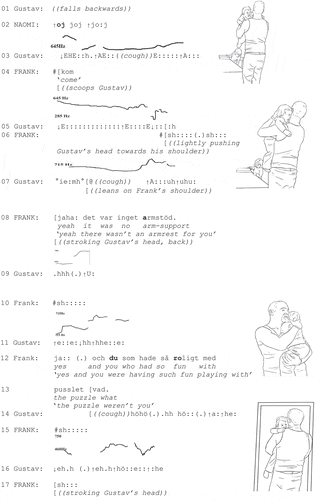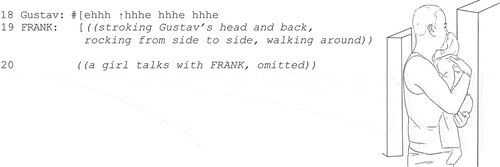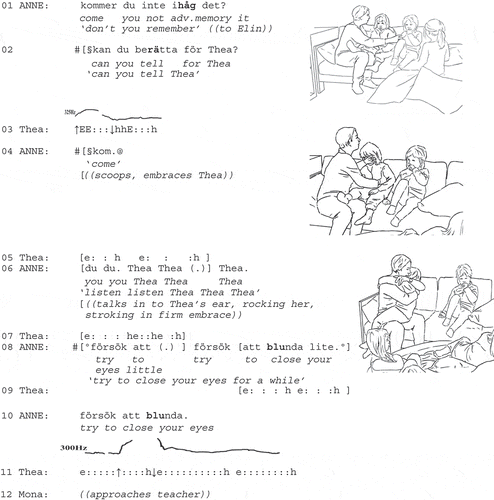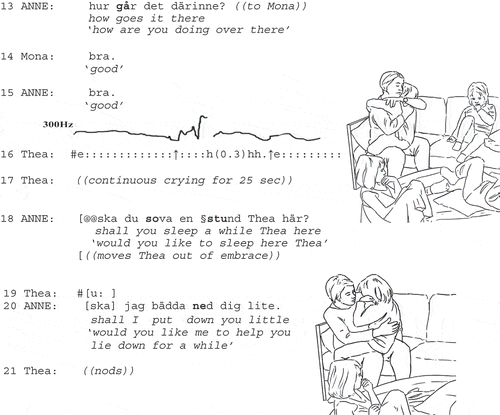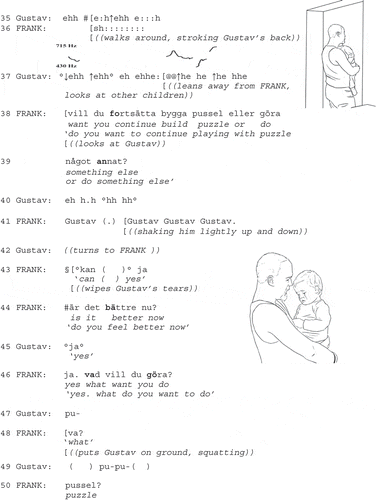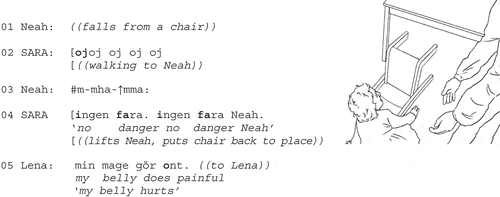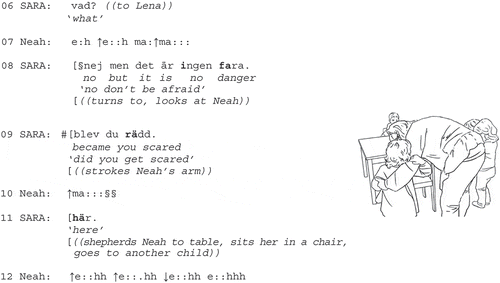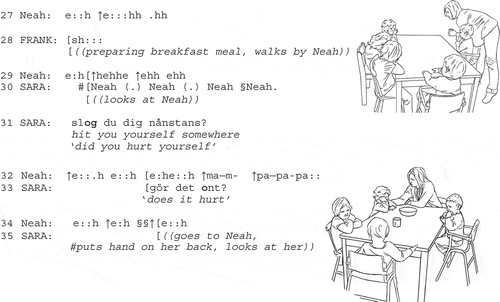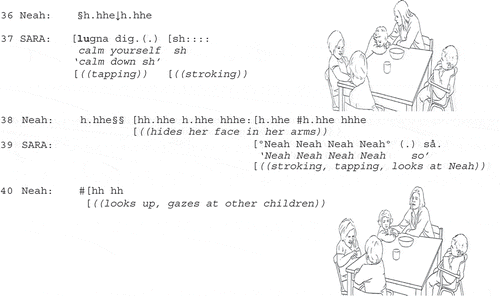ABSTRACT
The present study examines young children’s distress management in situ, focusing on situations of crying and caregivers’ embodied—haptic—soothing responses in preschools in Sweden. The adults’ responses to crying involve embraces, stroking, and patting. Haptic soothing is managed by calibrating the bodily proximity and postural orientations between the participants, including haptic—embracing or face-to-face—formations that are coordinated with particular forms of talk. Haptic formations configure specific affordances for embodied participation by actualizing the availability of tactile, aural, and visual modalities. The interactional organization of soothing in an embracing formation involves: an initiation/invitation and response, submergence of two bodies into a close haptic contact, and coordinated withdrawal from haptic contact. The embracing formation temporarily suspends the requirements for the distressed person to act like a responsive listener and speaker. The caregiver uses the face-to-face formation to reestablish conditions for the child’s interactional co-presence. Data are in Swedish and English translation.
Crying, especially children’s crying, is one of the most powerful and shared forms of human emotional expression. It is an obvious and easily identifiable manifestation of distress, characterized by the production of tears. In common understanding, it can signify various emotional responses—sadness, irritation, frustration, pain, or anger (Lutz, Citation1999). Hearing crying has strong moral and social implications concerning attending to another person’s distress. It is a powerful elicitor of responsive actions that range from soothing—using talk and touch—to disciplining. Comforting touch response is implied in the well-known sociological example of membership categorization provided by Harvey Sacks: “The baby cried. The mother picked him up” (Sacks, Citation1972, p. 330). Until recently, however, crying in situ, especially children’s crying, has been highly neglected as a subject of investigation within various research fields that have predominantly examined adults’ individual verbal accounts of crying (using interviews and questionnaires, Vengerhoets, Citation2013; but see Kidwell, Citation2013, on young children; Hepburn & Potter, Citation2012, on adults).
Among the issues of interest in understanding crying behavior, we find questions such as why and how children start and stop crying and how regulation of children’s distress can be accomplished using a full variety of situated—verbal and embodied/haptic—responses to crying (e.g., Vengerhoets, Citation2013). Thus far, however, the bodily aspects of crying situations have not received much attention, although the emerging approach to the haptic sociality of interaction (M. H. Goodwin, Citation2017) has highlighted touch as being one of the significant (thus far, greatly overlooked) communicative, affectively valenced modes of interaction and socialization.
Taking its point of departure in research in the multimodality of social interaction, particularly in the use of touch in emotion regulation, the present study examines young (2.5- to 5-year-old) children’s distress management in situ, focusing on situations of crying and caregivers’ embodied—haptic—soothing responses in preschools in Sweden. The specific interest is in the interactional organization of crying situations, while analytic attention is directed at the multimodal contextual (C. Goodwin, Citation2000) and spatial-orientational formations (Kendon, Citation1990), i.e., socioculturally meaningful corporeal units of participation in soothing practices. Emotion regulation is defined here as behaviors “that serve to modulate, inhibit, and enhance emotional experiences and expressions” (Calkins & Hill, Citation2007, p. 229). Focusing on the interactional organization of emotion regulation with young children, it is suggested here, can provide insights into the socialization templates for alleviation of distress.
Prior research on crying
Crying has long been recognized as a multifaceted physiological and social phenomenon. For instance, Darwin (Citation1998), who acknowledged the responsive function of emotion, suggested that crying is used to communicate discomfort. Cognitive theories have conceptualized “crying as a physiological effect of more significant mental processes” (Lutz, Citation1999, p. 112), and psychological and neuropsychological perspectives (that start from the individual’s experiences) have highlighted that crying helps reduce tension and facilitates physiological recovery following a state of distress (Miceli & Castelfranchi, Citation2003; Vengerhoets, Citation2013). Crying is a powerful way to communicate pain and distress to others and to evoke comfort and emotional support. Moreover, psychological developmental studies on infants’ crying have argued that touch, when it is used to alleviate distress, enhances attachment between the caregiver and the infant (Bowlby, Citation1969). Such responsiveness to a crying infant in an attempt to minimize distress or “motivate positive interaction” is important for developing a sense of security and trust (Bowlby, Citation1969; Calkins & Hill, Citation2007, p. 229).
According to social perspectives, crying is also “an integral part of a person’s social world and communication skills” (Lutz, Citation1999, p. 116), and its occurrence and form are related to the person’s emotional and expressive habits, which are shaped by interlocutors’ responses. Depending on a sociocultural context, the reasons for crying can be evaluated and crying can be disciplined, or on the contrary, soothing and comforting can be provided in an attempt to stop crying. Emotional and bodily interactional practices and the acceptability of affective touch, as suggested by historical accounts, are sensitive to socioemotional values and socialization goals (Classen, Citation2012). For instance, in a popular book on childrearing from the early 20th century, American psychologist Watson emphasized proscriptions against coddling and soothing because parents’ use of affective touch would lead to the child to develop a weak character (Montagu, Citation1971). A study conducted in the United States in the 1980s showed that preschool caregivers attended to children’s distress but that the affective (positive or negative) valence of their responses depended on the child’s gender (Phiney, Feshbach, & Farver, Citation1986). Managing crying in Chinese preschools (when crying was occasioned by separation distress) involved disciplining and shaming in order to foster the child’s self-control, which is associated with Confucian values (Hsuenh & Tobin, Citation2003). Thus, responses to crying are indexical of socioculturally poignant notions of social and moral personhood, and they display recipients’ stances on the appropriateness of the “why,” “how,” and duration of crying.
Studies from an interactional perspective have examined various institutional situations (police work, medical consultations, counseling) in which people (adults) are in distress and need help, suggesting that such situations may be generally conceptualized as overarching problem-remedy sequences (Beach & LeBaron, Citation2002, Hepburn & Potter, Citation2012; Kidwell, Citation2006, p. 531). They entail a variety of activities that are deployed to facilitate problem resolution: Remedy the trouble, alleviate distress, and return to the institutional activities. Interactional studies have thus far primarily examined adults’ verbal ways of responding to children’s distress (see Butler, Citation2014; Wooton, Citation2012). Kidwell (Citation2013) showed that even young children can respond with empathy to a peer’s crying by, for instance, handing her soothing objects. Children’s whining rather than full-scale tearful crying has received attention in several studies on parent-child interactions. As demonstrated by Wooton (Citation2012), a young child’s distress can be caused by the parent changing the course of action expected by the child. The child then uses whining to recruit the caregiver to provide a desired object (see also Butler, Citation2014). Whining situations are temporally extended, and children’s displays of negative emotions are, rather than being discrete emotional acts, interspersed with adults’ verbal attempts (e.g., inquiries) to remedy the problem and to manage the child’s affective stance (Butler, Citation2014; Wooton, Citation2012).
Touch in social encounters
The emergent interactional approach to haptic sociality has started identifying the communicative functions and uses of touch in relation to, for instance, adult-child directives, organizing and guiding interlocutors’ attention (Cekaite, Citation2010, Citation2016; M. H. Goodwin, Citation2006; M. H. Goodwin & Cekaite, Citation2013; Meyer, Streeck, & Scott Jordan, Citation2017), instructions (Burdelski, Citation2010; Käntää & Piirainen-Marsh, Citation2013), and health service encounters (Nishizaka & Sunaga, Citation2015). These studies have shown that the use of touch usually involves a multimodal sensorium, configured within specific spatial-orientational formations (Cekaite, Citation2010; M. H. Goodwin, Citation2006, Citation2017; McIlvenny, Citation2009). They have also suggested that the type, location, and timing of touch are associated with particular communicative features and the degree of affectivity. For instance, coordination and lamination of talk and touch are prevalent in control touch, which is deployed as responsive actions to children’s repeated noncompliance to verbal directives (Cekaite, Citation2015; M. H. Goodwin & Cekaite, Citation2013).
On the other hand, psychological perspectives originating in laboratory studies, while acknowledging that touch is rarely used on its own, set out to identify discrete, single-mode, haptic behaviors characterizing, for instance, prosocial emotions—love, gratitude, and sympathy—and suggest that sympathy is communicated by stroking, patting, holding, or hugging the other (Hertenstein & Weiss, Citation2011, p. 283). Similarly, neuroscientists have linked particular types of touch to feelings of reward and compassion, in that touch can trigger release of oxytocin (aka “the love hormone”; p. 283). Types of touch (as physiologically measurable phenomena) are also categorized according to their form, area, and intensity.
A few interactional studies dealing with touch and emotions have shown that affective tactile behaviors communicate intimacy and serve as “tie signs” that build cooperativeness and social trust in the community (Goffman, Citation1971, p. 252). M. H. Goodwin (Citation2017), in a study of hugs in “supportive interchanges” (greetings and farewells, Goffman, Citation1971) in U.S. middle-class families, revealed a systematic choreography of haptic intimacy. Such practices involve the sequential organization (invitation and responses) and lamination of multimodal resources (talk, voice quality, and touch) in the engagement of the hug.
Phenomenological approaches (grounded in individual retrospection), although not interested in the interactional potentials of touch per se, have argued that human intersubjectivity is embodied, i.e., intercorporeal. The notion of intercorporeality refers to primordial features such as the materiality and physicality of bodily existence, which involves sense-making of oneself and co-present others as corporeal subjects (Merleau-Ponty, Citation1964, p. 175; Meyer et al., Citation2017). Social (affectionate) touch allows us to experience “compresense,” i.e., “a single intercorporeality” when, in an engagement with other bodies, we embody the other while the other simultaneously embodies us (Merleau-Ponty, Citation1964, p. 168). In this way, touch blurs the boundaries between human beings who share corporeal experiences and actions with others (in a joint movement or sensation; Meyer et al., Citation2017).
As demonstrated by Kendon, a basic corporeal unit of participation (configured as spatial-orientational positioning of participants) involves a facing formation (F-formation), assembled whenever participants “orient their bodies in such a way that each of them has an easy, direct, and equal access to each other’s transactional segment” (including mutual gaze contact; Kendon, Citation1990, p. 239). In that the corporeal units of participation are constituted through participants’ “posture, orientation and distance, they thus indicate the degree of involvement, intimacy, and the type of affiliation” (Beach & LeBaron, Citation2002, p. 55). Touch, as a mode for haptic interaction, has thereby the potential to contribute to specific spatial, perceptual, and kinesthetic affordances and the organization of social interactional encounters.
Adopting the emerging interactional approach to haptic sociality, the present study examines distress management in situ (in so-called problem-remedy sequences; Kidwell, Citation2006), when young children’s distress is occasioned by various negative events (incidents, injuries, and conflicts). The primary analytical focus is on the multimodal organization of the sequence and the use of touch. Soothing is defined here as responses characterized by the caregiver’s emotion regulation through the use of positive emotions (talk and haptic means). Given the interest in the multiple modalities and senses involved in social interaction (Mondada, Citation2011; Streeck, Goodwin, & LeBaron, Citation2011) and socialization (Cekaite, Citation2010; M. H. Goodwin, Citation2006), the emphasis will be on the interactional organization of touch conduct. The goal is to generate knowledge about “haptic sociality” (M. H. Goodwin, Citation2017) and the emotional functions of touch in soothing children’s distress. Methodologically, the present study aims to contribute to the multimodal interaction analysis (C. Goodwin, Citation2000; Mondada, Citation2011) by combining detailed methodology for studying social interactions with phenomenological conception of intercorporeality (Merleau-Ponty, Citation1964; Meyer et al., Citation2017).
Method
Data and setting
The present study constitutes part of a larger research project that aims to examine embodied aspects of young children’s emotional and moral socialization in Swedish middle-class preschools and families.Footnote1 In Sweden, the majority of children attend preschools from 1.5 to 6 years of age. According to the Swedish National Curriculum (2016), preschools’ institutional task is to provide “educare”: Educational goals are closely linked to a caring relational approach, and safe, trusting relations between caregivers and children constitute one of the basic conditions of the institution.
The data were derived from two regular preschools in Sweden. One of the authors and a project researcher conducted a video-ethnography study at each preschool, using portable video recorders with an external microphone to document recurrent daily activities. The data include 20 hours of recordings of children’s (20 girls and boys, aged 2.5–5 years) interactions, collected in 2015 during a two-month period. Caregivers included one male and four female preschool teachers.
Analytical perspective and procedure
The recorded data were logged by viewing the video data, and crying instances were identified (50 in total). These cases were transcribed and systematically compared. The initial analyses dealt with the why and the who of the crying, the verbal and nonverbal uptake, including the type of haptic actions used. The type, intensity, duration (sustained/short embrace, light/strong stroking, tapping, pinching, shepherding (Cekaite, Citation2010), carrying), location, and function of touch were noted through repeated viewings of the video data in real-time and slow-motion microanalysis. Caregivers responded to all cases of distress, using talk (in all 50 cases) and various haptic acts (in 33 cases of crying).Footnote2 Twelve crying situations in which the adults used intensive haptic soothing acts (embraces deployed when crying was occasioned by painful experiences, injury, accident, peer conflicts) were selected for the present analysis. Spectrograms and pitch contours of crying tokens were produced using the acoustic software Praat and subsequently phonetically transcribed.Footnote3 Photoshop was used to anonymize video frame grabs and to transform them into line drawings. The three cases presented here are representative of the key variations in soothing practices where caregivers deployed amplified, temporally extended embraces.
The present study deploys a multimodal approach to situated interaction (C. Goodwin, Citation2000). Analytically, interaction analysis methods do not provide access to the individual’s intracorporeal experience. Rather, the analytical focus is on the interactional uptake of touch, displayed through the publicly visible and hearable actions of the participants (touch can be accepted or rejected), such as when a recipient does not respond in requested ways (moves away, grimaces).
Findings
As documented in the data, the caregivers responded to the children’s intensive crying, and the manifestation of distress interrupted the flow of the main institutional activities (e.g., play, educational activities, mealtimes). Management of the crying child became the main interactional business of the caregivers, initiated as part of their institutional duties to take care of and sooth the children and to ensure the progression of institutional work. Haptic soothing (embraces) was used to ameliorate the child’s distress, and the caregiver and child established what has been termed a problem (crying)-remedy sequence, which started with the problematic event that had occasioned the child’s crying. The sequence was terminated when there was a marked decrease in the child’s distress and when the adult got reassurance from the child that s/he had been soothed and was able to return to other activities. It usually involved a range of activities the adults used to ameliorate the child’s distress and to facilitate resolution (e.g., the use of haptic and verbal soothing, drawing attention to potential distractions, or negotiating the child’s return to the main institutional activities).
Haptic soothing was characterized by the adults’ use of temporally sustained embraces or partial embraces and was overlaid with and coordinated with specific verbal and vocal acts. In problem-remedy sequence, the caregiver and the child were positioned within particular spatial-orientational arrangements, assembled as corporeal—haptic—formations: head-to-head formation (H-formation, here also called “embracing formation”), formation of half-embrace, and face-to-face formation (M. H. Goodwin, Citation2006; Kendon, Citation1990).
In the following, we will examine the crying-soothing sequences with a particular focus on practices of haptic soothing and discuss how the haptic formations—embracing formation versus face-to-face formation—organize various activities in the crying situation, serving as: (a) a physical locus for the child’s main engagement in a sustained and absorbing experience of crying and multimodal soothing, or (b) a physical locus where the child is repositioned as a listener and conversational participant and where the adult can negotiate a recalibration of the child’s emotional state (e.g., solicit the child’s transition from soothing to neutrally valorized activities).
The dialogic and sensorial organization of a soothing embrace: Haptic “head-to-head” formation
In the current data, the caregivers used embraces as soothing, temporally sustained responses to the child’s intensive crying. Similarly to hugs in, for instance, greetings, soothing embraces were interactionally (sequentially) organized (M. H. Goodwin, Citation2017) in that they involved initiation/invitation and the recipient’s embodied response, and they were initiated by either of the parties: (a) the adult initiated or enforced the embrace by reaching out to or by scooping the child into her/his arms; (b) the crying child reached out toward the adult. The recipient’s aligning bodily response was assembled as acceptance of touch and active engagement in a close bodily—haptic—formation. Thus, a positive response was manifested in a number of ways, such as: (a) moving closer to and adjusting one’s bodily position to the other’s and (b) putting one’s arms around the provider of comfort. Such an embrace involved a particular haptic, head-to-head, formation, associated with the provision of amplified haptic contact, targeting a large bodily area of participants’ bodies and creating bodily togetherness, i.e., compresence (Merleau-Ponty, Citation1964), between the person in distress and the soother. In the following, we will explore the interactional and sensorial organization of a soothing embrace.Footnote4
In Extract 1, in response to Gustav’s accident (he falls down from a chair while playing with a puzzle) and crying, the preschool teacher Frank immediately picks him up and embraces him.Extract 1
The caregiver’s embrace amplifies the bodily contact space in that he not only scoops up and embraces the child but also moves Gustav’s head to rest on his shoulder, close to his head/cheek—an emotionally intense place for touch (Hertenstein & Weiss, Citation2011, p. 283; line 6). The caregiver’s caressing of Gustav’s head can also be seen as a way to sooth potential pain. The child reciprocates by leaning on the adult’s shoulder and adjusting to the form of the embrace (line 7). Upon Gustav’s increased crying, the caregiver carries him from the place of the accident, relocating crying-soothing to a transitional area, a corridor (line 15). The acoustic analysis of Gustav’s crying shows elongated cries, up to 2.7 s in duration (average of 0.4 s). The cries have a high fundamental frequency, ranging from around 400 Hz to a dramatic 800 Hz (the average for 2.5-year-olds being 300 Hz; Wilson, Citation1987).
As demonstrated in Extract 1, soothing in a heightened affective situation is associated with the provision of temporally extended and amplified haptic contact. A soothing embrace encompasses a large area of the child’s and adult’s bodies. Throughout the soothing situation (Extracts 1 and 3), the adult and the child sustain the close embracing formation (with the upper part of their torsos). Depending on the participants’ physical size and spatial position, reciprocated embrace may involve haptic contact between the participants’ faces (a highly innervated and sensitive area for touch (Hertenstein & Weiss, Citation2011), or the distressed child’s head may rest on the comforter’s chest or shoulder. Here, such positioning of the bodies is called a “head-to-head” haptic formation (H-formation). It builds on the notion of spatial-orientational positionings (Kendon, Citation1990) by taking into account the participants’ postural orientations, and extends it by conceptualizing a spatially and perceptually closer, intercorporeal, involvement.Footnote5
Amplifying haptic interface of “compresence” in a head-to-head formation
When Frank scoops the child into his arms and when he corrects Gustav’s head position (lines 4, 6), he solicits the distressed child’s corporeal trust in the adult’s bodily support. The child accommodates to the other’s corporeality by leaning close to the adult’s body (as discussed in Extract 1), giving control to the adult (Meyer et al., Citation2017), and even when the caregiver moves his hand away from the child’s head, the child sustains the head-to-head formation (lines 14–19). Viewed from a phenomenological perspective, a soothing embrace is a corporeal formation that involves an extended haptic surface of compresence (Merleau-Ponty, Citation1964): The soother and the child enter into and sustain an absorbing experience of bodily togetherness where joint sensations become possible. Arms are used by the “comforter” (or by both participants) to enclose the other into a haptic formation, a bodily canvass of “soothing” and “comforting” experience. Haptic, kinesthetic togetherness through “passive touch,”Footnote6 i.e., a temporally extended haptic interface of compresence, enables the child to experience and submerse into the soother’s bodily stability. The soother’s amplification of haptic contact is not limited to this temporally extended embrace but is embellished with frequent stroking and patting on the child’s upper body (head and back), affective (“active”Footnote7 ) touch associated with an expression of sympathy (lines 17, 19) (see Hertenstein & Weiss, Citation2011). The child positions himself as an aligning, receptive, and receiving party, available and amenable to the adult’s haptic soothing.
Lamination of talk and touch in a soothing embrace
Haptic soothing is a complex multimodal practice, involving lamination of touch, talk, and movement (lines 6–19). In the following, we will discuss the ways in which the use of soothing touch is coordinated with verbal and vocal resources. In lines 8 and 12–13, when the child’s crying temporarily ceases (as Gustav takes an in-breath), Frank comments on the accident “yeah there wasn’t an armrest for you”; “and you were having such fun playing with the puzzle, weren’t you”—describing the child’s abrupt transition from a happy to an unhappy, sad, emotional stance. He explains what has caused the trouble: Gustav’s chair did not have any armrests. These kinds of informing and affirming descriptions of the crying party’s trouble (declaratives or declaratives with tag questions) are common verbal resources, deployed in head-to-head soothing formation. Produced with sympathetic intonation, they display the adult’s affiliation (Butler, Citation2014; M. H. Goodwin, Citation2017) with the child’s affective stance. They describe the event that has caused crying, comment on and explain the incident, thus justifying the child’s emotional state—being scared, not feeling well (i.e., “motive” talk, Mills, Citation1940). Interestingly, in such a corporeal formation, the child does not have easy physical access to talk and to verbally replying to the soother. Thus, the caregiver can be seen to act as a narrator who, instead of requesting the child’s response, articulates and describes the connection between negative events and the child’s emotional stance: crying.
The adult’s talk (which is responsively attuned to crying in that it rarely overlaps crying tokens) also involves markedly elongated, soft, whispery sh:::: sounds (at times, combined with stroking) (lines 15, 17). Although they bear a formal resemblance with disciplining “shusshing” interjections, when they are produced in the head-to-head haptic formation—close to the child’s ear—they constitute embodied onomatopoetic resources and their soft, elongated features may have embodied resonating—calming—potential.
Head-to-head formation: Configuring soothing embrace as a multisensorial main involvement
The intensification of crying (when crying is caused by injury, pain, or sadness) was linked to the intensification of haptic and vocal soothing. As noted by Goffman, involvement in an interactional situation is guided by situational requirements that are moral character (1963, p. 240), and “[l]imits are put on those kinds of emigration of the self which can occur without leaving one’s physical position” (Goffman, Citation1963, p. 194), being and acting as an attentive co-present interlocutor, i.e., listener or speaker. Haptic soothing, configured as a head-to-head sustained formation, enables suspension of requirements for here-and-now conversational participation on the part of the child: The child is allowed to engage in complete “flooding out” (Goffman, Citation1961, p. 55), and crying-soothing is ratified as her/his main, fully corporeal, activity (both in relation to prior institutional activities and current activities going on around the child and the caregiver). The embracing formation allows assembling a multisensorial interactional hub for haptic and aural closeness and intimacy: Because it does not require gaze contact (in contrast to a face-to-face-formation), it decreases the public visibility as well as the vision of the person in distress. It thereby constitutes an intercorporeal locus for immersion into crying and soothing and supports the child’s main engagement into an absorbing experience that diverts her/his attention from the accident and engagement with the outer world.
In Extract 2, while the children were playing, one of them stepped on Thea’s (a 5-year-old girl) foot. Despite the teacher’s soothing attempts (which have already lasted for approximately 7 minutes), Thea continues crying. The teacher, in a face-to-face formation (and partial embrace), tries to solicit Thea’s participation in social interaction and to redirect her attention from crying. She asks Elin, a girl sitting nearby, to share some exciting (potentially distracting) information with Thea (lines 1–2). Thea responds with louder monotonous crying (line 3). Extract 2
The teacher’s direct attention—through address and gaze—to Thea requires the girl’s listenership and verbal response. It exposes and intensifies rather than decreases her crying (lines 1–3), occasioning the teacher’s amplified embodied and vocal soothing response (lines 4). Although the teacher already established a haptic contact with Thea, she now scoops up the child and arranges a close embracing (head-to-head) formation, demonstrating her corporeal affiliation with the child’s affective stance of distress. The caregiver coordinates this with vocal and verbal resources, producing talk and vocalizations close to Thea’s ear (lines 6, 8, 10). The repetitive and melodic soft summonses (“listen listen Thea Thea Thea”) are adapted to the child’s unceasing monotonous crying. Thea’s crying maintains a fundamental frequency of about 300 Hz (average for a 5-year-old child 250–275 Hz) on markedly elongated vowels, which range in duration from 1 to 3 s). The summonses are followed by directives (mostly produced in the clear) that require the child’s nonverbal compliance with the caregiver’s request that she close her eyes (försök att blunda lite “try to close your eyes for a while”; line 8, 10). Crying and soothing are thus choreographed as the main involvement of the child and an engulfing bodily experience, topically formulated as a visual time-out from the activities of the surrounding world. By verbally and haptically configuring a course of action, where the child is no longer positioned as a responsive interactant and where mutual gaze is no longer an interactional condition, the caregiver ratifies the child’s stepping out of a “basic obligation to comport oneself as potentially responsive when targeted by the actions of co-present others” (Kidwell, Citation2006, p. 745). Here, rather than visual, as in face-to-face interaction, another kind of—intercorporeal—mutual engagement is in play.
Thea continues crying for an extended period of time (lines 3–17), and the adult sustains the head-to-head formation, rocking from side to side and stroking Thea. The adult’s talk and vocal acts are adapted to crying, and their soothing potentials are made perceptually available for the recipient, in that they are slotted to avoid the overlap with crying and sobs (lines 6–10; e.g., the caregiver repeats her summonses so that they are finally produced with no overlap). Insofar as the notion of embodied agency is linked to the kinesthetic ability to feel one’s own movements (Sheets-Johnstone, Citation2002), reciprocal embrace as an intercorporeal formation implicates the submergence of distinct agencies because both the crying and soothing actors engage in a togetherness and compresense of intertwining bodies. The matters of agency are also actualized as bodily asymmetries between the participants: The adult is an embracing and supporting party who solicits the child’s bodily reliance on the stability of her support and who exerts some bodily control. An interim soothing condition is established when another child (Mona) pokes the caregiver to get her attention and the caregiver verbally establishes an overlapping participation framework—a conversational side-sequence (lines 12–15). In this multiactivity situation, soothing is accomplished primarily by bodily means (embrace, stroking), at the same time as the adult talks with another child.
The caregiver, after considerable soothing attempts, shifts from an embracing formation, arranging the child’s body into a face-to-face formation (lines 18–20), as she attempts to get the child to respond to her repeated interrogatives (ska du gå lägga dig? “would you like to sleep here Thea?,” line 18). This reconfiguration of the corporeal positioning and the interactional work accomplished thereby are discussed in the following section (Extract 3).
Negotiating transition from soothing to main institutional activity and a neutral emotional order: Reconfiguring haptic formations
The crying-soothing sequence is terminated only when there is a noticeable cessation of the child’s crying. The participants’ transition from soothing actions to the main institutional activities is not abrupt but is configured by using a range of (postsoothing) interactional moves, such as the adult probing the child’s perspective on the timeliness of a closure of the sequence. The transition involves a reconfiguration of a haptic formation as the adult withdraws from an embracing soothing position and establishes a face-to-face formation, characterized by the interactants’ mutual gaze (M. H. Goodwin, Citation2006; Kendon, Citation1990). In contrast to an embracing formation, where the child’s conversation participation is suspended, and crying-soothing is constituted as the main, corporeal, engagement for the child, in a haptic face-to-face formation, the adult-child gaze ratifies their return to a mutual encounter (C. Goodwin, Citation1981). Face-to-face haptic formation is laminated with verbal practices that require the child’s interactional co-presence (acting as a responsive interlocutor). Various formats of interrogatives are used to address the child when inquiring about his emotional state and readiness to reengage in the main course of institutional activities. Extract 3 is a continuation of Extract 1. The child’s crying continues for a while, and when it decreases, the caregiver attempts to return to the main course of institutional activities. He removes the child from the embracing formation and arranges a face-to-face formation (lines 29–34). Extract 3
The caregiver’s move into a face-to-face formation dissembles the affectively heightened embrace and is coordinated with an inquiry: är det bättre? (“do you feel better?”; lines 29–30). The interrogative is multifaceted: Frank inquires about the child’s emotional state, confirming the seriousness of crying. His yes/no question also directly addresses Gustav and invites the child’s response. “Eye-to-eye ecological huddle” is established, indicating the beginning of ratified mutual engagement (Goffman, Citation1963, p. 191; Goodwin, Citation1981). The emotional state (upset) itself is topicalized to probe whether the child is willing and ready to reengage in the main course of institutional activities (play). This haptic face-to face formation, together with verbal resources (interrogatives), requires the child’s interactional co-presence (acting as a listening and responding interlocutor). The caregiver requests that the child ratify termination of the crying-soothing sequence. The child’s positive response could signify a change in his emotional state and therefore provide legitimate ground to close this sequence. However, after Gustav’s negative response, which is interspaced with sobs (“no,” line 31), Frank, in interrogative format, suggests an alternative “rest?,” once again inquiring about the child’s perspective (line 32). Return to the institutional activities is postponed by further attending to the child’s distress (Beach & LeBaron, Citation2002). After Gustav’s crying nod (line 33), Frank reengages in haptic soothing, as he lightly pushes Gustav so that the child will lean on his shoulder (line 34, see also Ex. 1), thereby soliciting the child’s immersion into an haptic comforting, assembled as a head-to-head formation. Frank embellishes this with soothing sounds and stroking (lines 34, 36). The teacher’s reassemblage of the embracing formation can be seen as bodily emotion socialization, soliciting the child’s full immersion into embodied soothing. The child reciprocates and follows the adult’s touch (by leaning on the caregiver’s shoulder).
As Gustav’s crying decreases, he himself disengages from a soothing embrace (line 37) and looks at the children who are playing nearby. Frank once again probes for a return to the institutional activities, asking about the child’s next preferred activity (“do you want to continue playing with puzzle or do something else?,” lines 38–39). As he does not receive a clear-cut response, he sustains his gaze on Gustav and summons and lightly moves the child, achieving a reorientation of the child’s gaze (line 41). When a face-to-face formation is established, the caregiver inquires about the child’s experiential state again: “do you feel better now?” (line 44). In response to Gustav’s positive “yes” (i.e., the child’s consent and publicly visible modified emotional stance), the caregiver terminates the problem sequence and bodily transitions to the child’s preferred next play activity (“puzzle,” lines 47–50), putting the child on the floor.
Partial-embrace as a modulated haptic response to crying
Haptic soothing can vary in its affective intensity depending on the duration, timing, and types of touches used, including the extent of bodily contact between the participants. A recurrent haptic soothing formation involves a half-embrace in a side-to-side spatial-orientational positioning (Kendon, Citation1990). Touch here provides a haptic link between the person in distress and the soother, rather than haptic support for the child (cf. H-formation in Extracts 1 and 2). In Extracts 4a–4b, during busy breakfast preparations, the caregiver is engaged in multiple competing practical engagements, taking care of several children, when a 3.5-year-old girl, Neah, falls down from a chair and starts crying. She turns toward the caregiver Sara (line 1). The caregiver’s initial verbal and haptic consolation is short, and touch combines various, instrumental and affective, functions (line 4).Extract 4a
Sara quickly approaches the child. The direction of her haptic actions—lifting the child from behind, rather than scooping up and embracing the child—demonstrates a combination of instrumental and affective touch, as the caregiver shepherds Neah in a partial embrace toward the table and her chair (cf. full embraces in Extracts 1–3). Verbally, Sara describes the episode as not dangerous, repeating soothing statement (“no danger,” line 4), and engages in multiactivity by talking to another child. When Neah’s intensive crying continues (line 7), the caregiver orients to and explores the seriousness of the accident. Facing the child, while stroking Neah’s arm, she issues an interrogative “did you get scared?” (line 9), thus interpreting the cause of the girl’s crying to be her emotional response to the accident rather than injury. Rather than waiting for Neah’s response (cf. Extract 3), however, the caregiver quickly abandons soothing and resumes the interrupted institutional activity (breakfast preparations): She shepherds Neah to and places her in her seat (line 11), then moves on to other children.Extract 4b
Neah’s crying, however, continues, and the caregiver, while preparing breakfast (arranging the children in chairs around the table), resumes her interaction with Neah. She directs her gaze at Neah and summons her, asking whether Neah is in pain, using interrogatives to narrow down the reasons for crying (“did you hurt yourself?”; “does it hurt?”). While gazing at the caregiver, Neah responds with lexicalized crying, interspersed with increasing sobs (line 32): The child is still displaying intense distress and is not able to act as a fully co-present, interactionally capable interlocutor, in that the caregiver’s interrogatives fail to generate a comprehensive answer.
Upon such a display of intensive distress, the caregiver finally abandons her practical engagement, moves to the girl and initiates touch contact by putting her hand on the crying child’s back. She establishes a haptic link between the bodies, affiliating with the child’s affective stance. The caregiver configures a partial (or half-) embrace in a side-by-side formation, making her attention and emotional concern perceptually available, thus ratifying the girl’s crying, and crying-soothing is established as the main interactional activity for the girl and the caregiver (lines 35–39). The caregiver also modifies her verbal actions, moving from interrogatives (lines 31 and 33) to a directive to calm down. The girl lies down on the desk and hides her face in her hands, thus stepping outside the requirements and suspending her availability for “situational co-presence” (line 38; cf. Extracts 1 and 2, Goffman, Citation1963). Simultaneously, the caregiver sustains her gaze on the girl, using touch (stroking and tapping) and verbal soothing: whispery shhhh sounds and summonses. She thus assembles a temporally sustained multimodal complex of soothing acts, albeit using considerably less haptic contact (cf. Extract 2). When the girl’s crying decreases and she visually reorients to her peers, the caregiver also reorients to the other children (line 40).
The child deescalates and finishes crying only when her distress has been acknowledged by the adult’s sustained haptic contact (notice that Neah does not respond to the other caregiver’s vocal soothing shh, line 28). By initiating haptic soothing, the adult acknowledges and ratifies the child’s negative experience, suspends the requirements for the child’s situational co-presence and, using corporeal contact, s/he can alleviate the child’s distress.
Concluding discussion
Examined within actual stretches of interaction, the young children’s crying sequences reveal complex interactional practices for haptic soothing and emotion regulation. The adults’ responses to intensive crying involved a range of haptic resources, such as embraces, stroking, and patting. Problem-remedy sequences (starting with the child’s crying and terminated upon the cessation of distress) were managed by calibrating and modifying bodily proximity, contact, and postural orientations between the participants, including haptic—embracing or face-to-face—formations, and coordinating them with specific forms of verbal resources.
Haptic soothing practices and formations bring forth a variety of haptic perceptions. They involve the coexperience of each other’s body, as a part of interactionally organized reciprocal haptic acts. The interactional organization of soothing in an embracing formation (here also called head-to-head formation) manifests itself as: an initiation/invitation and response, submergence of two bodies into a close haptic contact, and coordinated withdrawal from haptic contact. Reciprocated soothing embraces involve the person in distress leaning his/her head against the soother’s head or shoulder, thereby establishing haptic contact between two faces, which are highly innervated and sensitive body areas. Haptic, kinesthetic togetherness through such “passive” touch, which in a stable manner encompasses a large area of the participants’ bodies (Hertenstein & Weiss, Citation2011, p. 283), establishes a temporally extended bodily surface of compresence (Merleau-Ponty, Citation1964) that involves the perception of and submersion into the soother’s bodily stability. Simultaneous stroking and tapping intensifies haptic experience and actualizes the roles of the giver and the recipient of touch, the comforter and the one being comforted, thus positioning the child as the recipient of affiliative sympathetic actions. A soothing embrace assembled when the adult scoops up and carries the child allows amplification of the interlocutors’ perceptual contact with various areas of another’s body (Extracts 1–3). In addition, it requires and presupposes the child’s embodied trust in the soother’s (caregiver’s) embodied support and physical strength, while also allowing for the adult’s embodied control. The affective intensity of soothing is calibrated by using various types of touch, as demonstrated by partial embrace, where the adult deploys touch to establish a corporeal link between the interlocutors (Extracts 3 and 4), using a lesser contact space and support compared to head-to-head formations. In various ways, the child’s trusting immersion into haptic soothing demonstrates the dialectics of care, affection, and control (Cekaite, Citation2015; M. H. Goodwin, Citation2017).
Head-to-head formation temporarily suspends the demands for attentive verbal participation in interaction, allowing the recipient (person in distress) to step outside the requirements to respond to the directed (verbal) actions of the others as well as to engage in full bodily engrossment in crying. The child is physically positioned so as to shift attention from the accident or conflict to the embodied experience of haptic soothing. Through haptic soothing practices, crying is constituted and ratified as the child’s main situational, fully corporeal, involvement, that is, an absorbing experience that diverts the crying person’s attention from and engagement with the outer world (Goffman, Citation1961).
Overall, the extracts (1–4) are informative about features that cut across such crying situations. They show the link between the child’s distress and emotion regulation using haptic means, demonstrating the participants’ (the child’s and adult’s) orientation toward haptic soothing as the appropriate and by the child expected affiliative affective response to intensive crying. The adults orient to the children’s crying as: (a) an elicitor of affective response, i.e., haptic soothing; (b) the child’s “need for expression of a certain emotion”; and (c) a way of mitigating and getting rid of the negative emotion itself (Miceli & Castelfranchi, Citation2003, p. 283). By initiating haptic soothing, the adult acknowledges and ratifies the child’s negative experience and, through corporeal contact, s/he can ameliorate the child’s distress.
Haptic formations and multimodal lamination of resources
Problem-remedy sequences are comprised of various activity phases (soothing, postsoothing), which are configured as specific haptic formations, laminated and coordinated with particular syntactic forms of talk. The head-to-head formation is overlaid with declaratives (Extract 1). Topically, the soother’s talk connects the child’s experiences and the events that have caused crying (“there wasn’t a armrest for you”) as well as deals with, labels, and describes the child’s experiences and feelings. While embrace enacts the ultimate closeness, “corporeal intersubjectivity” (Streeck et al., Citation2011), of the participants, the face-to-face formation establishes interactional conditions for the child’s responsivity and interactional co-presence (Extracts 3 and 4), in that the adult positions the child as a listener and interlocutor who able to make conversational contributions. The establishment of mutual gaze ratifies their mutual engagement and, when laminated with interrogatives, constitutes a new phase of the crying-remedy sequence (e.g., postsoothing or distraction). In this haptic formation, the adult can initiate negotiations about a return to the main institutional agenda. The adult’s postsoothing verbal actions (i.e., interrogatives) work to probe the child’s perspective about the timeliness of the transition to neutral emotional order, as the adult engages the child in emotion regulation, i.e., diagnostics and codecisions about the closure of crying-remedy sequence (Extract 3). Interrogatives concerning the child’s emotional experiences (är det bättre nu? “do you feel better now?”) or a new line of action (“do you want to continue playing with the puzzle or do something else?”) show that the child is positioned as a significant decision maker in relation to the development and duration of crying-soothing situation.
The study suggests that detailed interactional analysis can provide insights into the interactional templates that can inculcate the socioculturally sensitive norms and expectations related to the shaping of affective relations (Cekaite, Citation2010; M. H. Goodwin, Citation2006, Citation2017). Crying-soothing sequences constitute a multifaceted interactional space that involves in situ emotion regulation, management of the contingently evolving problems in children’s lives, as well as ongoing socialization. On a tentative note, the children in the data analyzed are being socialized to believe that intensive crying does not go unnoticed and that it is likely to result in an adult’s response. Crying is ratified as the main absorbing engagement of the child, and the caregivers allow the child to experience and express the intensive negative emotion. Rather than trying to quickly bring the child back to the main course of activities (but see Extract 4a) or to discipline the child (Hsuenh & Tobin, Citation2003), the caregivers choreograph nuanced corporeal support and soothing through intensive bodily togetherness, thus fostering the child’s adeptness to intercorporeal intersubjectivity.Footnote8 Getting rid of and ameliorating negative emotion is thus a collaborative and intimate—haptic—endeavor, where the caregivers display embodied concern for the children in distress. Moreover, the children are positioned as codecision makers concerning when they are ready to reenter the neutral emotional order. In this way, the child can learn from his or her own crying and from the soothing what kind of events may have led to the distress, and responses to crying can legitimize it or prompt the children to control their distress and to suppress overt manifestations of negative emotions.
Overall, detailed attention to the coordinated attunement of bodies in affectively heightened social interactions shows how the interactional shaping of social and affective relations combines multiple senses and extends beyond the use of language. The haptic sociality of soothing reveals the recurrent and recognizable ways in which humans, in social encounters, orient to each other as “the living body” (Merleau-Ponty, Citation1964), as well as the intercorporeal relations with the world. An examination of crying in situ that takes into account embodied responses and haptic comforting can thereby constitute a significant avenue for further investigation of emotion regulation in children, as well as in adults, simultaneously adding knowledge about the multimodal organization of social interaction.
Transcript conventions
Talk has been transcribed using the conventions developed by G. Jefferson. Original talk in Swedish is provided in regular type and indicative translation in italics.
| [ | = | indicates overlapping talk. |
| [(( | = | indicates the initial point of the participants’ movements or actions. |
| @ | = | indicates the onset of embracing formation. |
| @@ | = | indicates the endpoint of embracing formation. |
| § | = | indicates the onset of face-to-face formation. |
| §§ | = | indicates the endpoint of face-to-face formation. |
| # | = | indicates the point where screen shot has been taken. |
| FRANK | = | the caregiver is identified in capital letters. |
| Gustav | = | the child is identified in regular letters. |
| = | : indicates 0.2-second length of a crying token |
Funding
Financial support from Swedish Research Council (VR) is gratefully acknowledged.
Additional information
Funding
Notes
1 Preschool staff and all children’s parents were informed about the study aims and ethical procedures, and their informed consent was obtained. The data collection has followed the Swedish Research Council’s ethical guidelines for collecting and handling data. Names, images, and other identifiers have been anonymized.
2 The present data do not show gender- or age-related differences regarding the types and character of caregivers’ responses to crying.
3 Due to the intensive sound level in preschool groups (10–15 children playing in adjacent rooms), acoustic analysis was carried out when the technical conditions of the recording situation were satisfactory.
4 In the transcripts, the initial point of engagement and withdrawal from a particular haptic formation are indicated by using single and double @; § symbols. The particular haptic formation is sustained between these points.
5 While Kendon’s notion of spatial-orientational units of participant is centered around participants’ access to each other’s transactional segment (including gaze as a condition for organizing and coordinating social interaction), the haptic head-to-head formation suspends such requirements, and coordination is enabled through haptic contact rather than the participants’ publicly visible actions.
6 Passive touch (touch contact without movement, e.g., in embrace) involves cutaneous sensations on the surface of the skin (Hertenstein & Weiss, Citation2011, p. 254).
7 Stroking and tapping (active forms of touch) involve proprioception, i.e., stimulation of deeper tissue (Hertenstein & Weiss, Citation2011, p. 254). Passive and active types of touch provide for perceptually different (proprioceptional or cutaneous) experiences.
8 Given that “a sense of living self” is anchored in “tactile-kinesthetic life” (perceptions and motility of an infant) (Sheets-Johnstone, Citation2002, p. 139), exploration of the corporeal aspects of young child-adult interactions can provide an avenue for more fully considering “the ontogenetic development” of corporeal subjects (p. 139; Meyer et al., Citation2017).
References
- Beach, W., & LeBaron, C. (2002). Body disclosures. Journal of Communication, 52, 617–639. doi:10.1111/j.1460-2466.2002.tb02565.x
- Bowlby, J. (1969). Attachment and loss (Vol. 1). New York, NY: Basic Books.
- Burdelski, M. (2010). Socializing politeness routines: Action, other-orientation, and embodiment in a Japanese preschool. Journal of Pragmatics, 42, 1606–1621. doi:10.1016/j.pragma.2009.11.007
- Butler, C. (2014, July). Whining and crying: Children’s affective displays in family interaction. Paper presented at ICCA 2014, Los Angeles, CA.
- Calkins, S., & Hill, A. (2007). Caregiver influences on emerging emotion regulation. In J. Gross (Ed.), Handbook of emotion regulation (pp. 229–248). New York, NY: Guilford Press.
- Cekaite, A. (2010). Shepherding the child: Embodied directive sequences in parent-child interactions. Text & Talk, 30(1), 1–25. doi:10.1515/text.2010.001
- Cekaite, A. (2015). Coordination of talk and touch in adult-child directives: Touch and social control. Research on Language and Social Interaction, 48, 152–175. doi:10.1080/08351813.2015.1025501
- Cekaite, A. (2016). Touch as social control: Haptic organization of attention in adult-child interaction. Journal of Pragmatics, 92, 30–42. doi:10.1016/j.pragma.2015.11.003
- Classen, C. (2012). The deepest sense. A cultural history of touch. Urbana, IL: University of Illinois Press.
- Darwin, C. (1998). The expression of the emotions in man and animals. New York, NY: Oxford University Press. Original work published 1872.
- Goffman, E. (1961). Encounters. Indianapolis, IN: Bobbs-Merrill.
- Goffman, E. (1963). Behavior in public places: Notes on the social organization of gathering. New York, NY: Free Press.
- Goffman, E. (1971). Relations in public: Micro-studies of the public order. New York, NY: Harper and Row.
- Goodwin, C. (1981). Conversational organization: Interaction between speakers and hearers. New York, NY: Academic Press.
- Goodwin, C. (2000). Action and embodiment within situated human interaction. Journal of Pragmatics, 32, 1489–1522. doi:10.1016/S0378-2166(99)00096-X
- Goodwin, M. H. (2006). Participation, affect, and trajectory in family directive/response sequences. Text and Talk, 26, 515–544. doi:10.1515/TEXT.2006.021
- Goodwin, M. H. (2017). Haptic sociality: The embodied interactive construction of intimacy through touch. In C. Meyer et al. (Eds.), Intercorporeality: Beyond the body (pp. 73-102). Oxford, England: Oxford University Press.
- Goodwin, M. H., & Cekaite, A. (2013). Calibration in directive/response sequences in family interactions. Journal of Pragmatics, 46, 122–138. doi:10.1016/j.pragma.2012.07.008
- Hepburn, A., & Potter, J. (2012). Crying and crying responses. In A. Peräkylä & M. Sorjonen (Eds.), Emotion in interaction (pp. 195–212). Oxford, England: Oxford University Press.
- Hertenstein, M., & Weiss, S. (2011). The handbook of touch. New York, NY: Springer.
- Hsuenh, Y., & Tobin, J. (2003). Chinese early educators’ perspectives on dealing with a crying child. Journal of Early Childhood Research, 1, 73–94.
- Kääntä, L., & Piirainen-Marsh, A. (2013). Manual guiding in peer group interaction: A resource for organizing a practical classroom task. Research on Language and Social Interaction, 46, 322–343. doi:10.1080/08351813.2013.839094
- Kendon, A. (1990). Spatial organization in social encounters. The F-formation system. In A. Kendon (Ed.), Conducting interaction: Patterns of behavior in focused encounters (pp. 209–230). Cambridge, England: Cambridge University Press.
- Kidwell, M. (2006). “Calm down!”: The role of gaze in the interactional management of hysteria by the police. Discourse Studies, 8, 745–770. doi:10.1177/1461445606069328
- Kidwell, M. (2013). Interaction among children. In J. Sidnell & T. Stivers (Eds.), The handbook of conversation analysis (pp. 511–532). Malden, MA: Wiley Blackwell.
- Lutz, T. (1999). Crying: The natural and cultural history of tears. New York, NY: W. W. Norton.
- McIlvenny, P. (2009). Communicating a ‘Time-Out’ in parent-child conflict. Journal of Pragmatics: 41, 2017–2032.
- Merleau-Ponty, M. (1964). Signs (R. C. McCleary, Trans.). Evanston, IL: Northwestern University Press.
- Meyer, C., Streeck, J., & Scott Jordan, J. (2017). Intercorporeality: Emerging socialities in social interaction. Introduction. In C. Meyer, J. Streek, & J. Scott Jordan (Eds.), Beyond the body. Oxford, England: Oxford University Press.
- Miceli, M., & Castelfranchi, C. (2003). Crying: Discussing its uses and basic reasons. New Directions in Psychology, 21, 247–273.
- Mills, W. (1940). Situated actions and vocabularies of motive. American Sociological Review, V, 904–913. doi:10.2307/2084524
- Mondada, L. (2011). The organization of concurrent courses of action in surgical demonstrations. In J. Streeck, C. Goodwin, & C. LeBaron (Eds.), Multimodality in communication (pp. 207–226). Cambridge, England: Cambridge University Press.
- Montagu, A. (1971). Touching: The human significance of the skin. New York, NY: Columbia University Press.
- Nishizaka, A., & Sunaga, M. (2015). Conversing while massaging. Research on Language and Social Interaction, 48, 220–229. doi:10.1080/08351813.2015.1025506
- Phiney, J., Feshbach, A., & Farver, J. (1986). Preschool children’s response to peer crying. Early Childhood Research Quarterly, 1, 207–219. doi:10.1016/0885-2006(86)90030-X
- Sacks, H. (1972). On the analyzability of stories by children. In J. Gumperz & D. Hymes (Eds.), Directions in sociolinguistics (pp. 325–345). New York, NY: Holt, Rinehart and Winston.
- Sheets-Johnstone, M. (2002). Relationality and caring: An ontogenetic and phylogenetic perspective. Journal of Philosophy of Sport, 29, 136–148. doi:10.1080/00948705.2002.9714630
- Skolverket. (2016). Skolverkets allmänna råd – Färskolan. Stockholm, Sweden: Skolverket.
- Streeck, J., Goodwin, C., & LeBaron, C. (2011). Embodied interaction in the material world: An introduction. In J. Streeck, C. Goodwin, & C. LeBaron (Eds.), Multimodality in communication (pp. 1–28). Cambridge, England: Cambridge University Press.
- Vengerhoets, A. (2013). Why only humans weep. Oxford, England: Oxford University Press.
- Wilson, D. K. (1987). Voice problems of children (3rd ed.). Baltimore, MD: Williams and Wilkins.
- Wooton, A. (2012). Distress in adult-child interactions. In A. Peräkylä & M. Sorjonen (Eds.), Emotion in interaction (pp. 64–91). Oxford, England: Oxford University Press.

